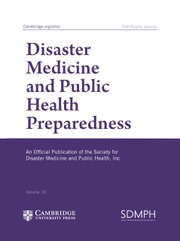Dear Editor,
The Noto Peninsula Earthquake occurred on January 1, 2024. The Noto peninsula projects upward from the coast of Ishikawa Prefecture, located in the central part of Japan’s main island, into the Japan Sea. The magnitude 7.5 earthquake caused severe damage to the community, resulting in 241 fatalities and 1290 injuries.1 Drawing upon the insights garnered from utilizing trailer houses during the 2018 Western Japan floods,Reference Inaba, Naito and Muramatsu2 our medical team, supported by the Ministry of Health, Labour, and Welfare Research Team, embarked on deploying mobile medical containers to disaster-stricken areas. The Noto earthquake challenged conventional disaster response mechanisms due to the severe climate (i.e., snowfall, cold weather) and cut-off roads. It disrupted public utilities, necessitating innovative approaches to health care delivery in evacuation centers.
Introducing mobile medical containers at Suzu City Elementary School’s evacuation center was a strategic response to the inadequacies of providing healthcare in constrained environments. These containers, operational from January 22, were installed to overcome the limitations of space and privacy that had hampered efficient medical service delivery. Also, the in-house clinic is more suitable for seeing patients than conventional medical tents during wintertime (Figure 1a). The experience of utilizing trailer houses in 2018 underscored the potential benefits of such modular units, paving the way for this initiative.1

Figure 1a. Mobile medical clinic in a snowy setting at Suzu City Elementary School, serving as an evacuation center. This clinic was critical for providing health care in severe winter conditions.
Equipped with essential facilities, including air conditioning, the containers facilitated a comfortable and private setting for patients and health care professionals. This environment was conducive to efficient medical care, including night-time services, which addressed the heightened need for medical attention as evacuees returned from day-long efforts of clearing debris and salvaging belongings.
However, the operation at Suzu City was accompanied by several difficulties. The installation of unnecessary but unremovable partitions in the container was because it was originally built as a temporary clinic room during the COVID-19 pandemic. The clinic was narrow and had insufficient space (Figure 1b). The flexible inside structure of a container is a future subject for improvement. And the logistical complexities of sourcing initial supplies within the disaster zone highlighted areas for improvement. Despite these hurdles, the favorable media coverage of our medical activity played a pivotal role in raising public awareness about the importance of adaptable and resilient health care solutions in disaster scenarios.

Figure 1b. Inside the mobile medical container. Despite space limitations, the setup facilitated effective medical care for disaster-affected individuals.
Reviewing the experience, it is evident that future disaster preparedness efforts must include pre-stocking medical containers with necessary supplies and having a prior agreement with potential facilities to serve as evacuation centers in case of disaster. Additionally, the deployment of multiple containers to form comprehensive outdoor medical facilities represents a viable strategy for enhancing health care delivery in future disasters.
In conclusion, this initiative has provided invaluable insights into the logistics, benefits, and challenges of utilizing medical containers in disaster response. We sincerely thank all contributors and the Ministry of Health, Labour, and Welfare Research Team for their unwavering dedication to this project. The lessons learned from the Noto Peninsula Earthquake 2024 will undoubtedly inform and improve health care delivery strategies in anticipation of future emergencies.
Acknowledgments
This work was supported by the Health and Labour Sciences Research Grant (Grant Number: 23IA1006). We sincerely appreciate the support provided.




